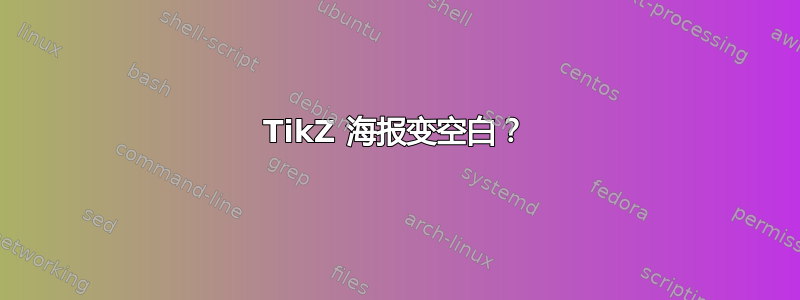
我用的是 Ti钾Z 制作会议海报,突然间,ShareLaTeX 内置的显示屏显示空白的绿色页面。我似乎无法将这种突然的变化归咎于单一原因。
我使用的代码如下(使用了模板)。抱歉格式不太好:
\documentclass[17pt, a0paper, landscape, margin=0mm, innermargin=15mm,
blockverticalspace=15mm, colspace=15mm, subcolspace=8mm]{tikzposter} %Default values for poster format options.
\newcommand{\bs}{\textbackslash} % backslash
\newcommand{\cmd}[1]{{\bf \color{red}#1}} % highlights command
\usepackage{amssymb,amsfonts,amsmath}
\usepackage{mathtools}
\usepackage[all,arc]{xy}
\usepackage{enumerate}
\usepackage{mathrsfs}
\usepackage{tikz-cd}
\usetikzlibrary{cd}
\usepackage{algpseudocode}
\usepackage[]{algorithm2e}
\usepackage{color}
\usepackage[compact]{titlesec}
\usepackage{tikz}
\usetikzlibrary{decorations.markings,arrows,automata,arrows,backgrounds,snakes}
\usetheme{Basic}
\begin{document}
\tikzset{->-/.style={decoration={
markings,
mark=at position .5 with {{->}}},postaction={decorate}}}
\title{Cosheaf Theoretical Constructions in Networks and Persistent Homology}
\settitle{\centering{\bfseries \fontsize{65}{78} \sc \@title \par}}
\maketitle[titletotopverticalspace=20mm]
\begin{columns}%blocks will be placed into columns
\column{.25}
\block[roundedcorners=40]{Introduction}{
Persistent homology has recently emerged as a powerful technique in topological data analysis for analyzing the emergence and disappearance of topological features throughout a filtered space, shown via persistence diagrams. Additionally, (co)sheaves have proven to be powerful instruments in tracking locally defined data across global systems, resulting in innovative applications to network science. In this paper, we combine the topological results of persistent homology and the quantitative data tracking capabilities of cosheaf theory to develop novel techniques in network data flow analysis. Specifically, we use cosheaf theory to construct persistent homology in a framework geared towards assessing data flow stability in hierarchical recurrent networks (HRNs). We use cosheaves to link topological information about a filtered network encoded in persistence diagrams with data associated locally to the network. From this construction, we use the homology of cosheaves as a framework to study the notion of “persistent data flow errors.” That is, we generalize aspects of persistent homology to analyze the lifetime of local data flow malfunctions. We proceed with several constructions motivated by the persistent homology of filtered topological spaces to fit our network theoretical environment. We conclude with an algorithmic construction of persistence diagrams parameterizing network data flow errors, thus enabling novel applications of statistical methods to study data flow malfunctions. Our results can be applied to analyze data flows in complex systems such as financial, social, and biological networks.
}
\block{Objective}{
We use cosheaf theory as a framework to develop network-theoretical generalizations of persistent homology to study network data flow malfunctions. These constructions are motivated by the use of statistical techniques to assess properties of persistence diagrams. Originally yielding valuable topological information about a filtered space, our framework enables the extraction of useful information pertaining to complex network data flow from a generalized notion of persistent homology.
}
\block{Background}{
\vspace{4mm}
\innerblock[\titlecenter, \roundedcorners]{Cosheaves}
{ Let $\mathscr{X}$ be a topological space and $\mathscr{J}$ an abelian category.
A \textit{$\mathscr{J}$-valued precosheaf} $\mathscr{F}$ on $\mathscr{X}$ is a covariant functor $\mathscr{F}\colon \mathrm{Open}(\mathscr{X}) \to \mathscr{J}$ from the category of open subsets of $\mathscr{X}$ to $\mathscr{J}$. If $U\subset \mathscr{X}$, an element $x\in \mathscr{F}(U)$ is a \textit{cosection} of $\mathscr{F}$ over $U$. For a pair of embedded open subsets $V \subset U \subset \mathscr{X}$, the induced map on the inclusion $\mathscr{F}(V)\to \mathscr{F}(U)$ is called the \textit{corestriction map.} A precosheaf $\mathscr{F}$on $\mathscr{X}$ is a \textit{cosheaf} if for any open $U \subset \mathscr{X}$ and any open cover $\{U_i\}$ of $U$, there is an exact sequence:
$\bigoplus_i\mathscr{F}(\bigcap_iU_i) \to \bigoplus_i\mathscr{F}(U_i) \to \mathscr{F}(U) \to 0.$
}
\vspace{4mm}
Essentially, cosheaf theory enables a structured assignment of data to open sets of a topological space.
\vspace{6mm}
\innerblock[\titlecenter, \roundedcorners]{Hierarchical Recurrent Networks}
{ Generally, a Hierarchical Recurrent Network (HRN) can be thought of as the digraph underlying a Hierarchical Recurrent Neural Network. For example the digraph $\mathscr{G}$ below is an HRN:
\begin{tikzpicture}[
decoration={markings,mark=at position 0.6 with {\arrow{latex}}},
scale=1.2]
\node[inner sep=1pt, circle, fill=black] (1) at (0,0) [draw] {};
\node[inner sep=1pt, circle, fill=black] (2) at (1,0) [draw] {};
\node[inner sep=1pt, circle, fill=black] (3) at (2,0) [draw] {};
\node[inner sep=1pt, circle, fill=black] (4) at (3,0) [draw] {};
\node[inner sep=1pt, circle, fill=black] (5) at (4,0) [draw] {};
\node[inner sep=1pt, circle, fill=black] (6) at (5,0) [draw] {};
\node[inner sep=1pt, circle, fill=black] (7) at (6,0) [draw] {};
\node[inner sep=1pt, circle, fill=black] (8) at (7,0) [draw] {};
\node[inner sep=1pt, circle, fill=black] (9) at (1.5,1) [draw] {};
\node[inner sep=1pt, circle, fill=black] (10) at (5,1) [draw] {};
\node[inner sep=1pt, circle, fill=black] (11) at (4,1) [draw] {};
\node[inner sep=1pt, circle, fill=black] (12) at (6,1) [draw] {};
\draw[->-] (1)--(2);
\draw[->-] (3)--(2);
\draw[->-] (3)--(4);
\draw[->-] (4)--(5);
\draw[->-] (6)--(5);
\draw[->-] (7)--(6);
\draw[->-] (7)--(8);
\draw[->-] (9)--(3);
\draw[->-] (2)--(9);
\draw[->-] (5)--(11);
\draw[->-] (10)--(6);
\draw[->-] (11)--(10);
\draw[->-] (12)--(7);
\draw[->-] (6)--(12);
\end{tikzpicture}
}
}
\column{.25}
\block{Approach}{
\vspace{75mm}
}
\block{}
{
If the default appearance of the title, background, blocks, and notes is not desired, you may change the colors by calling the color style along with a general layout theme with the commands
\begin{quote}
\texttt{\bs usecolorpalette}\{{\em color palette}\}\\
\texttt{\bs usecolorstyle\{{\em color style}\}}
\end{quote}
and
\begin{quote}
\texttt{\bs usetheme\{{\em layout style}\}}
\end{quote}
where the color palette and style and layout style are either the name of a custom made or one of the offered predefined choices listed in the manual or the comments of this poster's source. Individual changes can be made to the style of the background, title matter, blocks, inner blocks, and notes by using one of the following (along with either a custom-designed style or a predefined style listed in the manual or the comments of this poster's source). These changes are made with the commands
\begin{quote}
\texttt{\bs usebackgroundstyle[]\{\}, \bs usetitlestyle[]\{\},\\ \bs useblockstyle[]\{\},\bs innerblockstyle[]\{\}, \bs usenotestyle[]\{\}}
\end{quote}
Custom styles for these can be made; this is detailed in the manual.
}
\column{.25}
\column{.25}
\end{columns}
\end{document}
\endinput
%%
%% End of file `tikzposter-example.tex'.
答案1
您的代码
\innerblock[\titlecenter, \roundedcorners]{Cosheaves}
{Let $\mathscr{X}$ be a topological space and $\mathscr{J}$ an abelian category. [...]}
titlecenter是错误的: and前面不能有反斜杠roundedcorners;而且后者选项必须附带一个值。
所以它应该是这样的
\innerblock[titlecenter, roundedcorners=10pt]{Cosheaves}
{Let $\mathscr{X}$ be a topological space and $\mathscr{J}$ an abelian category. [...}}
还有一个错误:
\block{}
{
应该
\block{}
{
其中没有空行。



